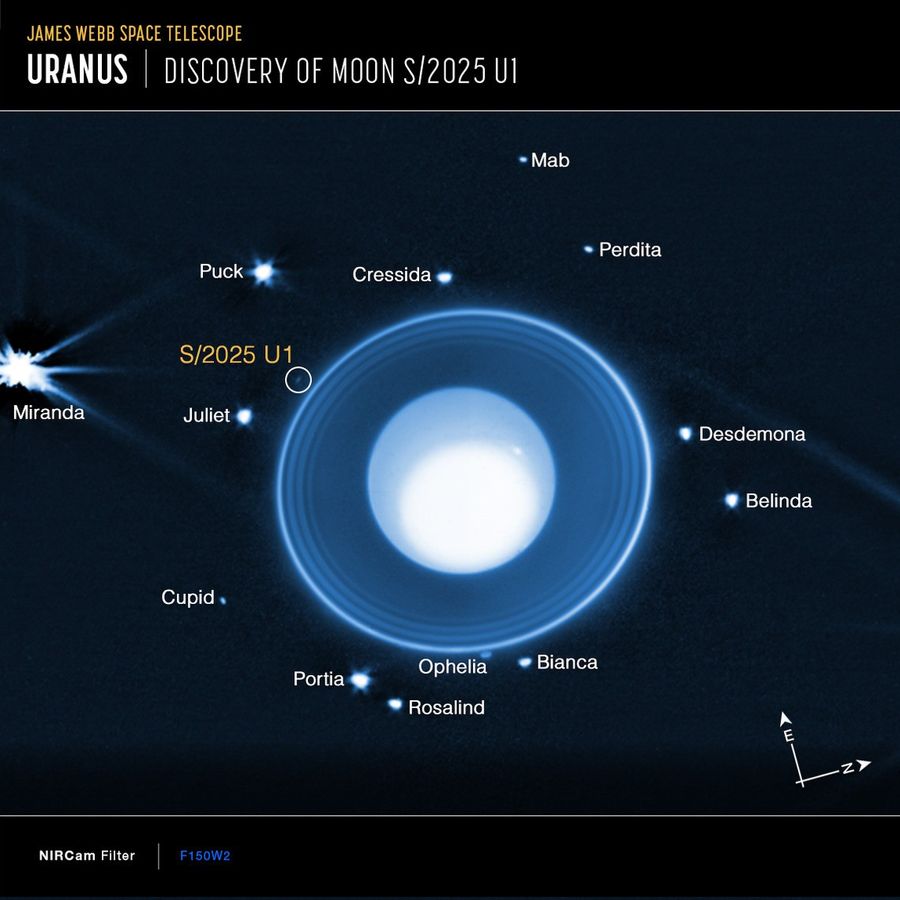The James Webb Space Telescope has spotted a never-before-seen moon orbiting Uranus, bringing the planet’s count of natural satellites to 29.
The moon, for now dubbed S/2025 U1, is just 6 miles (10 kilometers) in diameter, which is why it was invisible to other telescopes and the Voyager 2 spacecraft when it made its 1986 flyby of the icy planet.
Now, the James Webb Space Telescope’s (JWST) Near-Infrared Camera (NIRCam) has detected glints of sunlight in a series of 10 40-minute long-exposure images of Uranus, which revealed the elusive moon’s presence. The discovery hints that much more remains hidden around Uranus, the astronomers who found the moon say.
“No other planet has as many small inner moons as Uranus, and their complex inter-relationships with the rings hint at a chaotic history that blurs the boundary between a ring system and a system of moons,” Matthew Tiscareno, a senior research scientist at the SETI Institute in Mountain View, California, and a member of the research team, said in a statement. “Moreover, the new moon is smaller and much fainter than the smallest of the previously known inner moons, making it likely that even more complexity remains to be discovered.”
First spotted in 1781 by the German-British astronomer Frederick William Herschel, Uranus is the seventh planet from our sun and orbits it at a distance of 1.8 billion miles (2.9 billion km), nearly 20 times farther than Earth, according to NASA.

This extreme distance means that much of what we know about the far-flung, icy and lopsided planet comes from data gathered by NASA‘s Voyager 2 spacecraft, which zipped past the ice giant 40 years ago — yet even this information has been revised.
Related: Surprised scientists discover the ‘dark sides’ of Uranus’ moons are the wrong way around
The newfound moon, the 14th member of a system of small moons inside the orbits of the largest moons Miranda, Ariel, Umbriel, Titania and Oberon, is 35,000 miles (56,000 km) from Uranus’ center. It has a nearly circular orbit, meaning it may not have moved far from where it formed. Its location within Uranus’ dark inner rings (the planet has 13, divided into an inner system and an outer pair) likely explains why it went undetected for so long.
An official name for the newly discovered moon is awaiting approval by the International Astronomical Union (IAU), but it will most likely be named for a character from the works of Shakespeare or Alexander Pope, after which the planet’s other moons are named.
The JWST has made a number of astounding observations into the furthest reaches of our universe. But scientists say this discovery, made as part of the space telescope’s General Observer program, highlights the JWST ability to discover things at the outer limits of our own solar system.
“Looking forward, the discovery of this moon underscores how modern astronomy continues to build upon the legacy of missions like Voyager 2, which flew past Uranus on Jan. 24, 1986, and gave humanity its first close-up look at this mysterious world,” Maryame El Moutamid, a lead scientist at Southwest Research Institute’s Solar System Science and Exploration Division in Boulder, Colorado, said in the statement. “Now, nearly four decades later, the James Webb Space Telescope is pushing that frontier even farther.”
Source link

